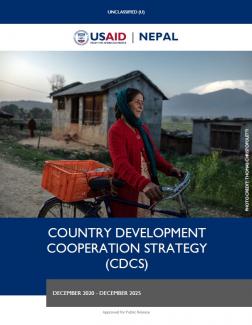Nepal faces enormous and complicated development challenges, including social exclusion, inadequate basic service delivery, insufficient economic opportunity and sources of growth, relatively new and largely untested decentralized processes and institutions, incomplete reconstruction from the 2015 earthquakes, and vast natural resources and biodiversity that require protection. The COVID-19 pandemic has made existing development challenges even more pronounced and dire. It has widened the gap between those who have access to resources and power, and those who do not; it has decreased economic activity and opportunity; it has forced up to 1 million Nepali migrant workers home from over a dozen countries; it has undermined key sectors of the economy that Nepal depends on for survival; and it has threatened to erase hard earned gains in health, education, and public service delivery.
The next five years are crucial for Nepal, not just to recover from COVID-19 and continue its previous development trajectory, but also to make the gains needed to attain its own goal of reaching middle income country status by 2030. To achieve this progress, Nepal will need to tap deeper into its own productive resources, implement policies that attract investment, and more aggressively engage the private sector in higher growth and more productive economic sectors, all the while building connectivity within the region. It also needs to ensure that its federal experiment is successful by giving voice, power, and authority to all of its diverse population. This will provide Nepal with a strong foundation for long-term inclusive, equitable, and sustainable economic growth and social development.
Built on this context, USAID’s goal for the 2020-2025 CDCS is “A more self-reliant, prosperous, and inclusive Nepal that delivers improved democratic governance and health and education outcomes.” Over the strategy period, USAID will make significant investments to increase self-reliance, prosperity, and inclusiveness that will advance Nepal’s development trajectory and allow Nepal to make impressive development gains that benefit all citizens. The first component of the goal, comprising the principles of self-reliance, prosperity, and inclusion cut across all aspects of the CDCS; they represent core elements crucial for Nepal’s development and are key to how the Mission will adapt its approach to build the capacity and institutions necessary to advance the Journey to Self-Reliance (J2SR) in Nepal.
The second component of the goal focuses on advancing democracy and human capacity development, each of which are intertwined and are dependent on how successful Nepal is in establishing and implementing federalism. For example, the provision of critical public services - namely, health and education - is a measure of the success of federalism and its implementation, and is inherently linked to citizen capacity. COVID-19 further complicates the situation, disproportionately affecting both health and education outcomes, reducing access and quality - especially for the most marginalized - exacerbating existing inequality and vulnerability. Because Nepal has made federalism a fundamental component to the success of its democracy, it features prominently throughout the CDCS. Federalism is also one of the essential mechanisms for increasing self-reliance, inclusiveness, prosperity, democratic governance, and human capacity development over the next five years.
To support Nepal’s development vision, USAID has woven three strategic approaches throughout the CDCS: Supporting the transition to federalism; Inclusion as a primary target of intervention; and, Integrating resilience into outcomes.
Building off of the J2SR Country Roadmap, evidence, and experience, USAID’s CDCS constructs a results framework (see diagram below) that establishes meaningful, achievable, and instrumental results to further Nepal on its J2SR. In support of the goal, USAID will implement the CDCS through four Development Objectives (DOs): DO 1 More Effective, Participatory, and Equitable Democratic Ecosystem; DO 2 Broad-Based and Inclusive Economic Growth Fostered; DO 3 Inclusive Health and Education Systems Strengthened; DO 4 More Equitable and Improved Natural Resources and Disaster Risk Management.
During the course of this CDCS, the Mission will make several strategic transitions and engage in new areas of collaboration with the Government of Nepal (GON) towards advancement of the J2SR. USAID will strategically shift from post-earthquake recovery to climate and disaster risk mitigation, and from health and education service delivery to systems strengthening. As new areas, USAID will support Nepal in strengthening broad-based economic growth in partnership with the private sector, in addition to continued engagement on agriculture; and integrate rule of law programs as an additional measure to consolidate democracy and strengthen the entire federal governance ecosystem. To implement these transitions, USAID assistance will more explicitly focus on sustainability and self-reliance issues related to financing self-reliance (FSR), private sector engagement (PSE), and building upon or redefining our development relationship (RDR) with GON counterparts. In regular consultation with all levels of government, donors, and civil society, the Mission will also pursue opportunities for USAID to adopt more locally-owned and -led development models; strengthen the host-country government’s ability - at the central and local levels - to continue to take the lead in addressing, managing and funding their own development challenges; and support partnerships and approaches that expand access to finance, mobilize private capital, and improve access to markets.

